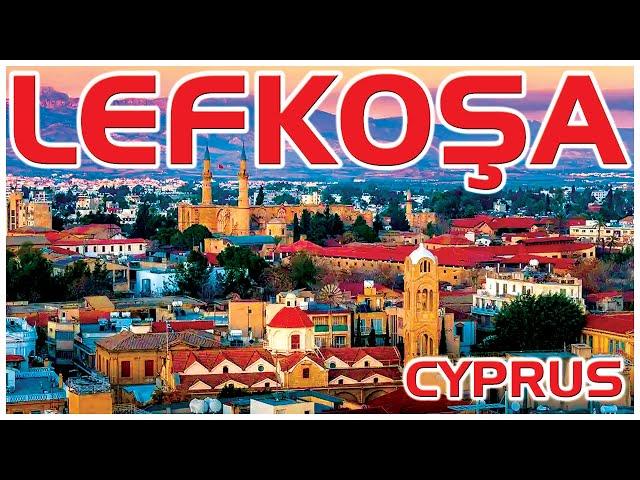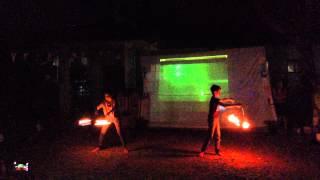
Nicosia Walking Tour - CYPRUS (KKTC)
Walk with me 👉 https://bit.ly/3O7D0vg
My walk map 👉 https://bit.ly/39d4hxW
Nicosia[b] (also known as Lefkosia in Greek[c] and Lefkoşa in Turkish[d]) is the capital and largest city of Cyprus. It is the southeasternmost of all EU member states' capital cities.
Nicosia has been continuously inhabited for over 4,500 years and has been the capital of Cyprus since the 10th century. It is the last divided capital in Europe; three years after Cyprus gained independence from British rule in 1960, the Bloody Christmas conflict between Greek Cypriots and Turkish Cypriots triggered island-wide intercommunal violence, and Nicosia's Greek Cypriot and Turkish Cypriot communities segregated into its south and north respectively in 1964. A decade later, Turkey invaded Cyprus following Greece's successful attempt to take over the island. The leaders of the takeover would later step down, but the dividing line running through Nicosia (and the rest of the island, interrupted only briefly by British military bases) became a demilitarised zone that remains under the control of Cyprus while heavily policed by the United Nations; it is now known as the United Nations Buffer Zone in Cyprus between the Republic of Cyprus, which is internationally recognised, and Northern Cyprus, which is recognised only by Turkey. The ongoing dispute between the two communities is known as the Cyprus problem.
Apart from its legislative and administrative functions, Nicosia has established itself as the island's financial capital and its main international business center. In 2018, Nicosia was the 32nd richest city in the world in relative purchasing power.
Names
The earliest mention of the city is on a clay prism of the Assyrian king Esarhaddon dated to 672 BC, which calls it Lidir. The local form of the name was later variously hellenized as Ledra (Greek: Λήδρα, Lḗdra),[citation needed] Ledrae (Λέδραι, Lédrai), Ledroi (Λήδροι, Lḗdroi), and Ledron (Λεδρῶν, Ledrō̂n, and Λῆδρον, Lē̂dron).
By late antiquity, early Christian sources were recording the location as Leuteon (Λευτεῶν, Leuteō̂n) and as Leucon (Λευκῶν, Leukō̂n), Leucotheon (Λευκοθέον, Leukothéon), Leucoi Theoi (Λευκοί Θεοί, Leukoí Theoí),[6] and Leucopolis (Λευκούπολις, Leukoúpolis), incorporating forms of the Greek words for "white" (λευκός, leukós) or "poplar" (λεύκη, leúkē) and for "God" (Θεός, Theós), "god" (θεός, theós), or "goddess" (θεᾱ́, theá), with possible allusion to a supposed son of Ptolemy I Soter or to the sea goddess Leucothea. During the Byzantine period, the form Leucosia (Λευκουσία, Leukousía)—usually parsed as intending "the white estate" (ἡ λευκή οὐσία, hē leukḗ ousía)—became common; this developed into modern Greek Lefkosia (Λευκωσία, Lefkosía, [lefkoˈsi.a]) and Turkish Lefkoşa ([lefˈkoʃa]).
The Latin and English name Nicosia appeared under the medieval Crusader Lusignan dynasty, around the same time the Cypriot port Limassol replaced its previous initial N with an L for similarly unknown reasons. Hill provides several other examples of interchanging /l/ and /n/ as far back as the Phoenician Cypriots, suggesting the exchange may have arisen from a variable native pronunciation. The name is also preserved as the Armenian Nikosia (Նիկոսիա) and the Cypriot Arabic Nikusiya.
History
For a chronological guide, see Timeline of Nicosia.
Prehistoric Nicosia
Main article: Ledra
Nicosia has been in continuous habitation since around 2500 BC near the beginning of the Bronze Age, when the first inhabitants settled in the fertile plain of Mesaoria.
The city-state of Ledra is similarly connected with the area of Nicosia, although the larger share of Mycenaean-era ruins in the area are at the broad hill of Ayia Paraskevi or Leondari Vounò 6 km (3.7 mi) southeast of central Nicosia. Ledra is reported as one of the twelve kingdoms of ancient Cyprus built by Achaeans after the end of the Trojan War. The kingdom was quickly destroyed. The Cypriot vassal state transcribed as "Lidir" in a 672 BC Assyrian text is generally identified with the remains which have been found nearer to the modern city. Its ruler Onasagoras[clarification needed] was recorded paying tribute to the Assyrian king Esarhaddon.
Ancient Nicosia
By 330 BC, Ledra was recorded to be a small unimportant town. It is thought that the settlement was economically and politically dependent on the nearby town of Chytri. The main activity of the town inhabitants was farming. During this era, Ledra did not have the huge growth that the other Cypriot coastal towns had, which was primarily based on trade.
Social Media / Contact
Twitter : https://twitter.com/travelwalking
Instagram : https://www.instagram.com/earthtravelwalkingtours
Facebook : https://www.facebook.com/Earth-Travel-Walking-Tours-102888222457618
Web : http://www.earthtravelwalkingtours.com
E-mail : [email protected]
My walk map 👉 https://bit.ly/39d4hxW
Nicosia[b] (also known as Lefkosia in Greek[c] and Lefkoşa in Turkish[d]) is the capital and largest city of Cyprus. It is the southeasternmost of all EU member states' capital cities.
Nicosia has been continuously inhabited for over 4,500 years and has been the capital of Cyprus since the 10th century. It is the last divided capital in Europe; three years after Cyprus gained independence from British rule in 1960, the Bloody Christmas conflict between Greek Cypriots and Turkish Cypriots triggered island-wide intercommunal violence, and Nicosia's Greek Cypriot and Turkish Cypriot communities segregated into its south and north respectively in 1964. A decade later, Turkey invaded Cyprus following Greece's successful attempt to take over the island. The leaders of the takeover would later step down, but the dividing line running through Nicosia (and the rest of the island, interrupted only briefly by British military bases) became a demilitarised zone that remains under the control of Cyprus while heavily policed by the United Nations; it is now known as the United Nations Buffer Zone in Cyprus between the Republic of Cyprus, which is internationally recognised, and Northern Cyprus, which is recognised only by Turkey. The ongoing dispute between the two communities is known as the Cyprus problem.
Apart from its legislative and administrative functions, Nicosia has established itself as the island's financial capital and its main international business center. In 2018, Nicosia was the 32nd richest city in the world in relative purchasing power.
Names
The earliest mention of the city is on a clay prism of the Assyrian king Esarhaddon dated to 672 BC, which calls it Lidir. The local form of the name was later variously hellenized as Ledra (Greek: Λήδρα, Lḗdra),[citation needed] Ledrae (Λέδραι, Lédrai), Ledroi (Λήδροι, Lḗdroi), and Ledron (Λεδρῶν, Ledrō̂n, and Λῆδρον, Lē̂dron).
By late antiquity, early Christian sources were recording the location as Leuteon (Λευτεῶν, Leuteō̂n) and as Leucon (Λευκῶν, Leukō̂n), Leucotheon (Λευκοθέον, Leukothéon), Leucoi Theoi (Λευκοί Θεοί, Leukoí Theoí),[6] and Leucopolis (Λευκούπολις, Leukoúpolis), incorporating forms of the Greek words for "white" (λευκός, leukós) or "poplar" (λεύκη, leúkē) and for "God" (Θεός, Theós), "god" (θεός, theós), or "goddess" (θεᾱ́, theá), with possible allusion to a supposed son of Ptolemy I Soter or to the sea goddess Leucothea. During the Byzantine period, the form Leucosia (Λευκουσία, Leukousía)—usually parsed as intending "the white estate" (ἡ λευκή οὐσία, hē leukḗ ousía)—became common; this developed into modern Greek Lefkosia (Λευκωσία, Lefkosía, [lefkoˈsi.a]) and Turkish Lefkoşa ([lefˈkoʃa]).
The Latin and English name Nicosia appeared under the medieval Crusader Lusignan dynasty, around the same time the Cypriot port Limassol replaced its previous initial N with an L for similarly unknown reasons. Hill provides several other examples of interchanging /l/ and /n/ as far back as the Phoenician Cypriots, suggesting the exchange may have arisen from a variable native pronunciation. The name is also preserved as the Armenian Nikosia (Նիկոսիա) and the Cypriot Arabic Nikusiya.
History
For a chronological guide, see Timeline of Nicosia.
Prehistoric Nicosia
Main article: Ledra
Nicosia has been in continuous habitation since around 2500 BC near the beginning of the Bronze Age, when the first inhabitants settled in the fertile plain of Mesaoria.
The city-state of Ledra is similarly connected with the area of Nicosia, although the larger share of Mycenaean-era ruins in the area are at the broad hill of Ayia Paraskevi or Leondari Vounò 6 km (3.7 mi) southeast of central Nicosia. Ledra is reported as one of the twelve kingdoms of ancient Cyprus built by Achaeans after the end of the Trojan War. The kingdom was quickly destroyed. The Cypriot vassal state transcribed as "Lidir" in a 672 BC Assyrian text is generally identified with the remains which have been found nearer to the modern city. Its ruler Onasagoras[clarification needed] was recorded paying tribute to the Assyrian king Esarhaddon.
Ancient Nicosia
By 330 BC, Ledra was recorded to be a small unimportant town. It is thought that the settlement was economically and politically dependent on the nearby town of Chytri. The main activity of the town inhabitants was farming. During this era, Ledra did not have the huge growth that the other Cypriot coastal towns had, which was primarily based on trade.
Social Media / Contact
Twitter : https://twitter.com/travelwalking
Instagram : https://www.instagram.com/earthtravelwalkingtours
Facebook : https://www.facebook.com/Earth-Travel-Walking-Tours-102888222457618
Web : http://www.earthtravelwalkingtours.com
E-mail : [email protected]
Тэги:
#travel #walk #walking #tours #trip #tour #outing #tourism #トラベル #歩く #ウォーキング #ツアー #市内旅行 #シティウォーク #目覚めている街 #トルコを歩く #イスタンブールを歩いて #カッパドキアを歩いて #徒歩旅行 #viajar #caminando #tournées #city_trip #city_walk #walking_in_turkey #walking_in_istanbul #walking_in_Cappadocia #walking_tour #viaje_a_la_ciudad #paseo_por_la_ciudad #ciudad_despierta #caminando_en_pavo #caminando_en_estambul #promenade_en_ville #sultan_suleiman #hurrem_sultan #El_siglo_magnífico #imperio_otomano #ottoman_empireКомментарии:
Parallel Lines (Pfirter Remix)
Release - Topic
Nicosia Walking Tour - CYPRUS (KKTC)
Earth Travel Walking Tours
Trenuri Transferoviar Calatori Trains Cluj Napoca-Bratca-Cluj Napoca in Muntii Apuseni Mountains
Trains & Machinery LDEGM Trainspotter
INFLUENCERZY BEZ CENZURY (FILM DOKUMENTALNY)
Karol Friz Wiśniewski
સુંદર ભજન: દસા, આશાપુરા, અને બહુચર મા | Priti Patel | Gujarati Mataji Bhajans
Maa Recording Studio
fire dance duo_Nina Maria scholars
Hope Bidlisiw
TACTICAL STRIKE MELHOR JOGADOR 2025
ztzghosts
Yunex Traffic Netherlands - Bedrijfsfilm NL
Yunex Traffic

![Определение расстояния по сетке оптического прицела. Mil Dot [sub] Определение расстояния по сетке оптического прицела. Mil Dot [sub]](https://rtube.cc/img/upload/a19QY0EwcGVLN0c.jpg)
























